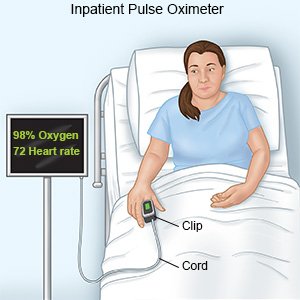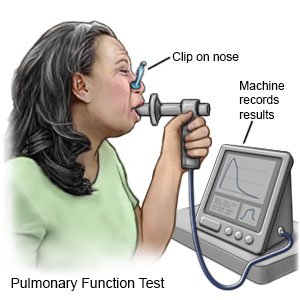Emphysema
Medically reviewed by Drugs.com. Last updated on Aug 4, 2025.
Emphysema is a long-term lung disease. Emphysema is part of a group of lung diseases called chronic obstructive pulmonary disease (COPD). Emphysema damages the alveoli (air sacs) in your lungs. This makes it hard for your lungs to send oxygen to the rest of your body.
 |
WHILE YOU ARE HERE:
Informed consent
is a legal document that explains the tests, treatments, or procedures that you may need. Informed consent means you understand what will be done and can make decisions about what you want. You give your permission when you sign the consent form. You can have someone sign this form for you if you are not able to sign it. You have the right to understand your medical care in words you know. Before you sign the consent form, understand the risks and benefits of what will be done. Make sure all your questions are answered.
Monitoring:
- A pulse oximeter is a device that measures the amount of oxygen in your blood. A cord with a clip or sticky strip is placed on your finger, ear, or toe. The other end of the cord is hooked to a machine.

- An EKG records your heart rhythm and how fast your heart beats.
Medicines:
- Bronchodilators open your airway so you can breathe easier. They are most often given through an inhaler or nebulizer.
- Steroids help decrease swelling in your airway.
- Antibiotics treat a bacterial infection.
Related medications
Tests:
- Blood tests measure the amount of oxygen, acids, and carbon dioxide in your blood. They also check for infection.
- A chest x-ray will show if you have lung damage or other lung problems.
- Pulmonary function tests (PFTs) measure how well your lungs exchange gases and how much air your lungs can hold. PFTs can also show if your lungs respond to certain medicines.

- A sputum sample is collected in a cup when you cough. It is sent to a lab to check for a lung infection.
- A bronchoscopy is a procedure to look inside your airway to find the cause of your airway or lung condition. A bronchoscope (thin tube with a light) is inserted into your mouth and moved down your throat to your airway. You may be given medicine to numb your throat and help you relax during the procedure. Tissue and fluid may be collected from your airway or lungs to be tested.
Treatment:
- Extra oxygen may be needed if your oxygen level is low. Oxygen may be given through a face mask or a nasal cannula.
- Surgery or a procedure maybe needed if other treatments do not work. Ask your provider about surgery or procedure options.
- Noninvasive positive-pressure ventilation, or NPPV, may be used to help you breathe. A machine helps your lungs fill with air by using a mask or a mouthpiece. If a mask is used, it may go over your nose and mouth, or just your nose. Extra oxygen may be given to you through the machine.
- A ventilator is a machine that gives you oxygen and breathes for you when you cannot breathe well on your own. An endotracheal (ET) tube is put into your mouth or nose and attached to the ventilator. You may need a trach if an ET tube cannot be placed. A trach is a tube put through an incision and into your windpipe.
Treatment options
The following list of medications are related to or used in the treatment of this condition.
RISKS:
- Emphysema increases your risk for lung infections. One or both of your lungs can collapse. You are at greater risk for lung cancer. Lack of oxygen may cause damage to your organs, such as your heart or kidneys. You may develop heart disease. You may have an irregular heartbeat or high blood pressure. You may develop heart failure. You can have a heart attack. You can have respiratory failure. This can be life-threatening.
- Your muscles may get smaller, and you may have severe weakness. You are at greater risk for osteoporosis (brittle bones) and broken bones.
CARE AGREEMENT:
You have the right to help plan your care. Learn about your health condition and how it may be treated. Discuss treatment options with your healthcare providers to decide what care you want to receive. You always have the right to refuse treatment.© Copyright Merative 2025 Information is for End User's use only and may not be sold, redistributed or otherwise used for commercial purposes.
The above information is an educational aid only. It is not intended as medical advice for individual conditions or treatments. Talk to your doctor, nurse or pharmacist before following any medical regimen to see if it is safe and effective for you.
Learn more about Emphysema
Treatment options
Care guides
Symptoms and treatments
Medicine.com guides (external)
Further information
Always consult your healthcare provider to ensure the information displayed on this page applies to your personal circumstances.
